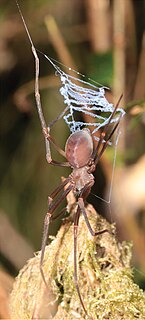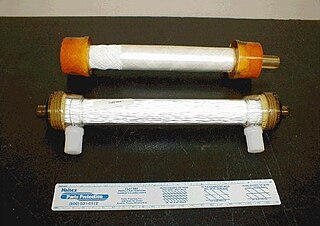
The Kimura spider, or kimura-gumo in Japanese, Heptathela kimurai, is an Old World spider, found primarily in Japan and named after Arika Kimura, who collected it in 1920. It belongs to the sub-order Mesothelae and can reach up to 3 cm in length. Its burrows are covered by a camouflaged "pill box" flap.

Spider silk is a protein fibre spun by spiders. Spiders use their silk to make webs or other structures, which function as sticky nets to catch other animals, or as nests or cocoons to protect their offspring, or to wrap up prey. They can also use their silk to suspend themselves, to float through the air, or to glide away from predators. Most spiders vary the thickness and stickiness of their silk for different uses.

Fiber or fibre is a natural or synthetic substance that is significantly longer than it is wide. Fibers are often used in the manufacture of other materials. The strongest engineering materials often incorporate fibers, for example carbon fiber and ultra-high-molecular-weight polyethylene.

Spitting spiders are members of the spider family Scytodidae. There are several genera, of which Scytodes is the best-known. Over 150 species of scytodids have been described worldwide.

Ground spiders include nearly 2,000 described species in over 100 genera, distributed worldwide. This makes the family the seventh largest known. New species are still being discovered. They are closely related to Clubionidae.

Aeroplankton are tiny lifeforms that float and drift in the air, carried by the current of the wind; they are the atmospheric analogue to oceanic plankton.

The dwarf sheet spiders are small spiders, their bodies are about 2 mm in length. They build extremely delicate webs in the form of a sheet, and unlike many spiders the web does not lead to a retreat. The silk used in these webs is so fine that they are difficult to spot unless they are coated with dew. They greatly favor locations near water or near moss, and are often found in leaf litter and detritus or on the leaves of shrubs and trees.

The tree trunk spiders are members of the tropical and semi-tropical family Hersiliidae. There are about 150 species in this family. These spiders have two very prominent spinnerets that are almost as long as their abdomen. So they are also sometimes known as "two-tailed spiders". They range in size from about 10 mm to 18 mm long. Being very well camouflaged for life on the varicolored trunks of trees, they have an interesting way of capturing prey. Rather than making a web that captures prey directly, they lay a light coating of threads over an area of tree bark and wait hidden in plain sight for an insect to stray onto that patch. Once that occurs, they direct their spinnerets toward their prey and circle it; all the while casting silk on it. When the hapless insect has been thoroughly immobilized, they can bite it through its new shroud.

Cribellum literally means "little sieve", and in biology the term generally applies to anatomical structures in the form of tiny perforated plates.

The evolution of spiders has been going on for at least 380 million years, since the first true spiders evolved from crab-like chelicerate ancestors. More than 45,000 extant species have been described, organised taxonomically in 3,958 genera and 114 families. There may be more than 120,000 species. Fossil diversity rates make up a larger proportion than extant diversity would suggest with 1,593 arachnid species described out of 1,952 recognized chelicerates. Both extant and fossil species are described yearly by researchers in the field. Major developments in spider evolution include the development of spinnerets and silk secretion.

The anatomy of spiders includes many characteristics shared with other arachnids. These characteristics include bodies divided into two tagmata, eight jointed legs, no wings or antennae, the presence of chelicerae and pedipalps, simple eyes, and an exoskeleton, which is periodically shed.

Ballooning, sometimes called kiting, is a process by which spiders, and some other small invertebrates, move through the air by releasing one or more gossamer threads to catch the wind, causing them to become airborne at the mercy of air currents, and more importantly, electric currents. This is primarily used by spiderlings to disperse; however, larger individuals have been observed doing so as well. The spider climbs to a high point and takes a stance with its abdomen to the sky, releasing fine silk threads from its spinneret until it becomes aloft. Journeys achieved vary from a few metres to hundreds of kilometres. Even atmospheric samples collected from balloons at five kilometres altitude and ships mid-ocean have reported spider landings. Mortality is high.

A spider web, spiderweb, spider's web, or cobweb is a structure created by a spider out of proteinaceous spider silk extruded from its spinnerets, generally meant to catch its prey.

Attercopus is an extinct genus of arachnids, containing one species Attercopus fimbriunguis, known from a Devonian-aged fossil. It is placed in the extinct order Uraraneida, spider-like animals able to produce silk, but which lacked true spinnerets and retained a segmented abdomen bearing a flagellum-like tail resembling that of a whip scorpion. They are thought to be close to the origins of spiders.

Spiders are air-breathing arthropods that have eight legs and chelicerae with fangs able to inject venom. They are the largest order of arachnids and rank seventh in total species diversity among all orders of organisms. Spiders are found worldwide on every continent except for Antarctica, and have become established in nearly every habitat with the exceptions of air and sea colonization. As of November 2015, at least 45,700 spider species, and 113 families have been recorded by taxonomists. However, there has been dissension within the scientific community as to how all these families should be classified, as evidenced by the over 20 different classifications that have been proposed since 1900.
This glossary describes the terms used in formal descriptions of spiders; where applicable these terms are used in describing other arachnids.

Hollow fiber membranes (HFMs) are a class of artificial membranes containing a semi-permeable barrier in the form of a hollow fiber. Originally developed in the 1960s for reverse osmosis applications, hollow fiber membranes have since become prevalent in water treatment, desalination, cell culture, medicine, and tissue engineering. Most commercial hollow fiber membranes are packed into cartridges which can be used for a variety of liquid and gaseous separations.

Uraraneida is an extinct order of arachnids, known from fossils of Middle Devonian, Permian and possibly Cretaceous age. Two genera of fossils have been definitively placed in this order: Attercopus from the Devonian of United States and Permarachne from the Permian of Russia. In 2018, a third genus Chimerarachne, from the Cretaceous of Myanmar was proposed to belong to this group, but this placement is disputed. When the first fossils were found, they were identified as spiders, but now constitute the Uraraneida, a separate but closely related group.


















